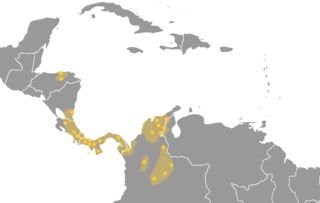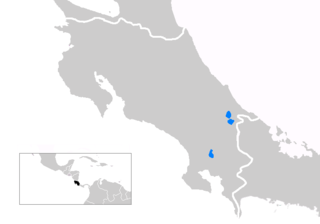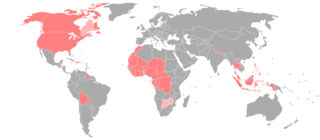Related Research Articles

Costa Rica, officially the Republic of Costa Rica, is a country in the Central American region of North America, bordered by Nicaragua to the north, the Caribbean Sea to the northeast, Panama to the southeast, the Pacific Ocean to the southwest, and maritime border with Ecuador to the south of Cocos Island. It has a population of around five million in a land area of 51,060 km2 (19,710 sq mi). An estimated 333,980 people live in the capital and largest city, San José, with around two million people in the surrounding metropolitan area.

The Chibchan languages make up a language family indigenous to the Isthmo-Colombian Area, which extends from eastern Honduras to northern Colombia and includes populations of these countries as well as Nicaragua, Costa Rica, and Panama. The name is derived from the name of an extinct language called Chibcha or Muysccubun, once spoken by the people who lived on the Altiplano Cundiboyacense of which the city of Bogotá was the southern capital at the time of the Spanish Conquista. However, genetic and linguistic data now indicate that the original heart of Chibchan languages and Chibchan-speaking peoples might not have been in Colombia, but in the area of the Costa Rica-Panama border, where the greatest variety of Chibchan languages has been identified.

Quiripi was an Algonquian language formerly spoken by the indigenous people of southwestern Connecticut and central Long Island, including the Quinnipiac, Unquachog, Mattabessett, Podunk, Tunxis, and Paugussett. It has been effectively extinct since the end of the 19th century, although Frank T. Siebert, Jr., was able to record a few Unquachog words from an elderly woman in 1932.
UNAPROA was founded by deputies of six village communities in the Brunca Region in the year 1995. This association has the ambition of promoting the organic agriculture and green tourism. Its domicile is situated in El General in Costa Rica. The members are mostly campesinos, who husband small fields at the Talamanca mountains. Meanwhile the community has grown and now embraces deputies of forty villages, one of them indigenous. UNAPROA has cooperated for several years with the Austrian magazine Grünen Bildungswerkstatt.

The Asociación de Guías y Scouts de Costa Rica is the national Scouting and Guiding association of Costa Rica. Scouting was founded in Costa Rica in 1915 and became a member of the World Organization of the Scout Movement in 1935. Guiding started in 1922 and became a member of the World Association of Girl Guides and Girl Scouts in 1946. The association has more than 14,500 members of both genders.
Brazilian Sign Language is the sign language used by deaf communities of urban Brazil. It is also known in short as Libras and variously abbreviated as LSB, LGB or LSCB.

The Boruca are the indigenous people living in Costa Rica. The tribe has about 2,660 members, most living on a reservation in the Puntarenas Province in southwestern Costa Rica, a few miles away from the Pan-American Highway following the Rio Terraba. The ancestors of the modern Boruca made up a group of chiefdoms that ruled most of Costa Rica's Pacific coast, from Quepos to what is now the Panamanian border, including the Osa Peninsula. Boruca traditionally spoke the Boruca language, which is now nearly extinct.

The Brunca Region is one of six socioeconomic regions in Costa Rica. It has a varied landscape, ranging from the coasts to interior mountains.
The Boruca language is the native language of the Boruca people of Costa Rica. Boruca belongs to the Isthmian branch of the Chibchan languages. Though exact speaker numbers are uncertain, UNESCO’s Atlas of the World’s Languages in Danger has listed Boruca as "critically endangered". It was spoken fluently by only five women in 1986, while 30 to 35 others spoke it non-fluently. The rest of the tribe's 1,000 members speak Spanish.

Bribri, also known as Bri-bri, Bribriwak, and Bribri-wak, is a Chibchan language, from a language family indigenous to the Isthmo-Colombian Area, which extends from eastern Honduras to northern Colombia and includes populations of those countries as well as Nicaragua, Costa Rica, and Panama. As of 2002, there were about 11,000 speakers left. An estimate by the National Census of Costa Rica in 2011 found that Bribri is currently spoken by 54.7% of the 12,785 Bribri people, about 7,000 individuals. It is a tonal language whose word order is subject–object–verb.

The following is an alphabetical list of topics related to the Republic of Costa Rica.

Térraba River, in the southern Brunca region of Costa Rica, is the largest river in that country.
A village sign language, or village sign, also known as a shared sign language, is a local indigenous sign language used by both deaf and hearing in an area with a high incidence of congenital deafness. Meir et al. define a village sign language as one which "arise[s] in an existing, relatively insular community into which a number of deaf children are born." The term "rural sign language" refers to almost the same concept. In many cases, the sign language is known throughout the community by a large portion of the hearing population. These languages generally include signs derived from gestures used by the hearing population, so that neighboring village sign languages may be lexically similar without being actually related, due to local similarities in cultural gestures which preceded the sign languages. Most village sign languages are endangered due to the spread of formal education for the deaf, which use or generate deaf-community sign languages, such as a national or foreign sign language.
Old Costa Rican Sign Language is a deaf-community sign language of San Jose, spoken by people born before about 1945. Along with American Sign Language, it is one of the sources of New Costa Rican Sign Language.
Bribri Sign Language is a village sign language of an indigenous Bribri community in southern Costa Rica. It is unrelated to Costa Rican Sign Language.

San Isidro de El General is the first district of the canton of Pérez Zeledón, in the southern part of the province of San José in Costa Rica, as well as the name of said district's main city.
Brunca is one of six socioeconomic regions of Costa Rica.

Paso Canoas is an international city shared between Puntarenas Province in Costa Rica and Chiriquí Province in the west of Panama. The border between Costa Rica and Panama crosses Paso Canoas from north to south, with the result that the city is both Costa Rican and Panamanian.

American Sign Language (ASL) developed in the United States and Canada, but has spread around the world. Local varieties have developed in many countries, but there is little research on which should be considered dialects of ASL and which have diverged to the point of being distinct languages.
Brunca or Brunka or Brunga was a town of ancient Bithynia on the coast of the Propontis, on the road from Nicomedia to Libyssa, 13 M.P. from the former and 12 M.P. of the latter.
References
- ↑ Brunca Sign Language at Ethnologue (25th ed., 2022)
